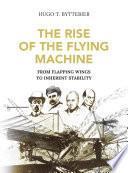The Rise of the Flying Machine
Resumen del Libro

This important work of history tells the story of the aviation pioneers who devoted their lives, and often their fortunes, to the evolution of the aeroplane as it exists today. As early as November 1809 Sir George Cayley published a masterly essay practically inventing the aeroplane. It lay forgotten for 62 years, until found by Alphonse Pénaud. In August 1871 Pénaud flew his Planophore, the first model to resemble a modern aeroplane. He had discovered the secret of inherent longitudinal stability. The first flying machine built by Clément Ader, in 1889, was the Eole. Powered by a steam engine, he claimed to have flown in it, but there were no official witnesses. The first recorded, powered and manned flight in history, by Orville Wright in the USA on 17th December 1903, was achieved with a flying machine that required masterly skills to pilot it. The Wrights believed in the technical predominance of their design and tried to turn it into a monopoly, generating much controversy. Santos Dumont achieved the first world record for speed, distance and duration, taking to the air by means of the first powered take-off in the now standard manner in France on 23rd October 1906. This book is a comprehensive description of the continuous evolution that made the heavier than air flying machine possible, through the struggle of pioneers such as Victor Tatin, Octave Chanute, Léon Levavasseur with his V8 engines and the Antoinette, S.P. Langley and his Aerodrome, Captain Ferdinand Ferber, Charles Voisin, Louis Blériot and Glenn Curtiss, among others.
Más detalles de libro
Cantidad de páginas 950
Autor:
- Hugo Byttebier
Categoría:
Formatos Disponibles:
MOBI, EPUB, PDF
Descargar Ebook
Valoración
3.7
16 Valoraciones Totales







